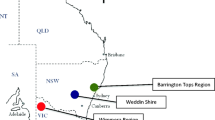Abstract
The density of wild honeybee colonies (Apis mellifera) in the African dry highland savannahs was estimated in three Nature Reserves in Gauteng, South Africa (Ezemvelo, Leeuwfontein, Suikerbosrand) based on the genotypes of drones which were caught at drone congregation areas. Densities were estimated to range between 12.4 and 17.6 colonies per square kilometer. In addition colony densities were estimated in two German National parks (Müritz and Hochharz) and a commercial mating apiary. The density of colonies was significantly lower at the German sampling sites with estimates of 2.4–3.2 colonies per square kilometer, which closely matches the nation-wide density of colonies kept by beekeepers. This shows that the densities of colonies observed in wild populations under the harsh conditions of the African dry savannahs exceeds that of Germany by far, in spite of intensive beekeeping. The intensity of apiculture in Europe is therefore unlikely to compensate for the loss of habitats suitable for wild honeybees due to agriculture, forestry and other cultivation of land.

Similar content being viewed by others
References
Baudry E, Solignac M, Garnery L et al (1998) Relatedness among honeybees (Apis mellifera) of a drone congregation. Proc R Soc Lond B 26:2009–2014
Biesmeijer JC, Roberts SPM, Reemer M et al (2006) Parallel declines in pollinators and insect-pollinated plants in Britain and the Netherlands. Science 313:351–354
Cornuet JM, Aries F (1980) Number of sex alleles in a sample of honeybee colonies. Apidologie 11:87–93
Estoup A, Solignac M, Cornuet JM (1994) Precise assessment of the number of patrilines and of genetic relatedness in honeybee colonies. Proc R Soc Lond B 258:1–7
von Frisch K (1967) The dance language and orientation of bees. Belknap Press of Harvard University Press, Cambridge MA
Harrison JF, Taylor OR, Hall HG (2005) The flight physiology of reproductives of Africanized, European, and hybrid honeybees (Apis mellifera). Physiol Biochem Zool 78:153–162
Hepburn HR, Radloff SE (1998) Honeybees of Africa. Springer, Berlin, Heidelberg, New York
Kevan PG, Phillips TP (2001) The economic impacts of pollinator declines: an approach to assessing the consequences. Conserv Ecol 5:8
Koeniger N, Koeniger G, Pechhacker H (2005) The nearer the better? Drones (Apis mellifera) prefer nearer drone congregation areas. Insect Soc 52:31–35
Kraus B, Page RE (1995) Effect of Varroa jacobsoni (Mesostigmata: Varroidae) on feral Apis mellifera (Hymenoptera: Apidae) in California. Environ Entomol 24:1473–1480
Kraus FB, Neumann P, Scharpenberg H et al (2003) Male mating success of honeybee colonies (Apis mellifera L.). J Evol Biol 16:903–913
Kraus FB, Neumann P, van Praagh J, Moritz RFA (2004) Sperm limitation and the evolution of extreme polyandry in honeybees (Apis mellifera L.). Behav Ecol Sociobiol 55:494–501
McNally LC, Schneider SS (1996) Spatial distribution and nesting biology of colonies of the African honeybee Apis mellifera scutellata (Hymenoptera: Apidae) in Botswana, Africa. Environ Entomol 25:643–652
Moritz RFA, Southwick EE (1992) Bees as superorganisms – an evolutionary reality. Springer Verlag, Berlin, Heidelberg, New York
Moritz RFA, Härtel S, Neumann P (2005) The western honeybee (Apis mellifera L.): an invasive species? Ecoscience 12:289–301
Nei M (1987) Molecular evolutionary genetics. Columbia University Press, New York
Neumann P, van Praagh JP, Moritz RFA, Dustmann JH (1999) Testing the reliability of a potential island mating apiary using DNA microsatellites. Apidologie 30:257–276
Oldroyd BP, Thexton EG, Lawler SH, Crozier RH (1997) Population demography of Australian feral bees (Apis mellifera). Oecologia 111:381–387
Park SDE (2001) Trypanotolerance in West African Cattle and the population genetic effects of selection. Dissertation, University of Dublin
Raymond M, Rousset F (1995a) An exact test for population differentiation. Evolution 49:1280–1283
Raymond M, Rousset F (1995b) GENEPOP (version 1.2): population genetics software for exact tests and ecumenicism. J Heredity 86:248–249
Roubik DW (1978) Competitive interactions between neotropical pollinators and Africanized honeybees. Science 201:1030–1032
Roubik DW (2000) Pollination system stability in tropical America. Conserv Biol 14:1235–1236
Roubik DW, Wolda H (2001) Do competing honey bees matter? Dynamics and abundance of native bees before and after honey bee invasion. Popul Ecol 43:53–62
Ruttner F (1966) The life and flight activity of drones. Bee World 47:93–100
Ruttner F (1988) Biogeography and taxonomy of honeybees. Springer Verlag, Berlin, Heidelberg, New York
Ruttner H, Ruttner F (1966) Untersuchungen über die Flugaktivität und das Paarungsverhalten der Drohnen. 3. Flugweite und Flugrichtung der Drohnen. Z Bienenforsch 8:332–354
Ruttner F, Ruttner H (1972) Untersuchungen über die Flugaktivität und das Paarungsverhalten der Drohnen. V. Drohnensammelplätze und Paarungsdistanz. Apidologie 3:203–232
Schneider SS, DeGrandi-Hoffman G, Smith DR (2004) The African honey bee: factors contributing to a successful biological invasion. Annu Rev Entomol 49:351–376
Seeley TD (1985) Honeybee ecology. Princeton University Press, Princeton
Solignac M, Vautrin D, Loiseau A et al (2003) Five hundred and fifty microsatellite markers for the study of the honeybee (Apis mellifera). Mol Ecol Notes 3:307–311
Statistisches Bundesamt Deutschland (2005) Umwelt-Bodenflächen nach Art der tatsächlichen Nutzung. http://www.destatis.de./basis/d/umw/ugrtab7.php. Cited 27 Sept 2006
Taylor OR, Rowell GA (1987) Drone abundance, queen flight distance and the neutral mating model for the honey bee, Apis mellifera. In: Needham GR, Page RE, Delfinado-Baker M, Bowman CE (eds) Africanized bees and bee mites. Ellis Hoorwood, Chichester, pp 173–183
Walsh PS, Metzger DA, Higuchi R (1991) Chelex 100© as a medium for simple extraction of DNA for PCR-based typing from forensic material. Biotechniques 10:506–513
Wang J (2004) Sibship reconstruction from genetic data with typing errors. Genetics 166:1963–1979
Weir BS, Cockerham CC (1984) Estimating F-statistics for the analysis of population structure. Evolution 38:1358–1370
Williams JL (1987) Wind-directed pheromone trap for drone honey bees (Hymenoptera: Apidae). J Econ Entomol 80:532–536
Acknowledgements
We thank the EU DG12 (RFAM) and the VW foundation (RFAM, RMC) for funding this work. Gauteng Nature Conservation and Strilli Oppenheimer of E Oppenheimer & Son kindly allowed for the capture of bees within their reserves in South Africa.
Author information
Authors and Affiliations
Corresponding author
Rights and permissions
About this article
Cite this article
Moritz, R.F.A., Kraus, F.B., Kryger, P. et al. The size of wild honeybee populations (Apis mellifera) and its implications for the conservation of honeybees. J Insect Conserv 11, 391–397 (2007). https://doi.org/10.1007/s10841-006-9054-5
Received:
Accepted:
Published:
Issue Date:
DOI: https://doi.org/10.1007/s10841-006-9054-5




